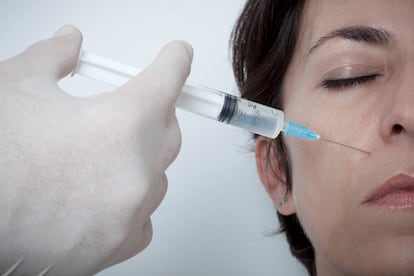Why do the effects of Botox last for less and less time? The mystery that has aesthetic medicine perplexed
Frequency of injections, the body’s immune response and errors in the administration of the drug can shorten the amount of time a patient will enjoy their desired results

It’s a recurring question in aesthetic medicine practices, and a visit to internet message boards shows that it’s one that doctors and patients have been asking for years: Is it true that the effects of Botox, the brand that two decades ago became the popular generic name for botulinum toxin, are increasingly short-lived?
The implications of this query go far beyond private doubts in front of one’s bathroom mirror. Firstly, because of its economic repercussions. Botulinum toxin is the most widely used treatment in aesthetic medicine. Last year, 332,000 vials of the drug were sold in Spain for aesthetic purposes at a cost of $85 million, according to numbers provided by specialized consultancy firm Iqvia. And secondly, because the debate is highly scientific, being the subject of dozens of articles published in medical journals and untold hours of discourse at industry forums.
“It is true that the effects of the toxin sometimes last less than expected. But its causes, in general, are not so much found in the substance itself, but in patient characteristics or inadequate administration,” says Fernando García Monforte, a physician specializing in the field, and co-author of a recently published study in scientific journal Medicina Estética entitled Toxina botulínica. ¿Por qué dura menos? Una revisión desde nuestra experiencia (in English, Botulinum toxin: Why does it last less? A review based on our experience).
The substance originates in a protein produced in nature by bacteria from the species Clostridium botulinum. Because of its potent neurotoxic effect, it poses a risk in the food sector, where it can cause serious poisoning in the form of botulism when these microorganisms contaminate edible products such as canned food. “It causes paralysis of muscles by inhibiting the release of acetylcholine, which is the transmitter used by neurons to communicate with each other. In practice, this causes the nerve endings to stop giving orders to the muscles,” explains Francisco Zaragoza, professor of pharmacology at Madrid’s University of Alcalá de Henares.
The same effect that makes it dangerous — a person who is intoxicated by the bacteria will choke to death when their breathing muscles cease functioning — gives the toxin enormous potential in the medical field if applied locally, in tiny doses. In aesthetic medicine, botox is commonly used to “eliminate or attenuate facial wrinkles such as those on the forehead, between the eyebrows and around the eyes,” says Juan Antonio López Pitalúa, president of the Spanish Society of Aesthetic Medicine (SEME). In other areas of medicine, the toxin is used in various muscular ailments — particularly dystonia — and for some kinds of migraines, among other maladies.
García Monforte’s article presents the problem in its first paragraph: “Complaints about the shorter duration of the toxin’s effect on patients are cause for concern among physicians,” since “it is common to hear that, when performing a new treatment with the same brand of toxin as a previous treatment, that the duration of the effect is shorter.”
In response to questions from EL PAÍS, the author details numerous factors that shed light on this apparent mystery. “Some of them have to do with the way the toxin is administered. It is a protein that can degrade if not handled correctly, which can reduce it effectiveness and, therefore, the duration of its effects. I like to say that the toxin lasts less time when administered by certain people,” he says. Shaking the product, for example, should be avoided at all costs. The manufacturer’s instructions should also be followed in detail when reconstituting the toxin, which is sold in vials containing a powder that must be diluted in saline solution and then kept at a low temperature.
“If used too frequently, the body will develop antibodies that also can shorten effects,” says García Monforte. To avoid this, injections should be spaced out for aesthetic purposes, but it is important to also keep in mind that the toxin is used in the healthcare system for various neurological, muscular or pain-related ailments. “People often do not connect the fact that the medication that they were injected with at the hospital is the same or very similar to the one we use. That’s why you should always ask for all information, including brand name. Not all toxins are the same, and we can achieve better results if we take all these factors into account,” says the physician.
Lastly, experienced physicians know that other factors can play a role. “The effects of the toxin last less in summer, for example. That’s due to the heat and the sun, which warm the skin and contribute to the degradation of the toxin. People going through stressful moments also tend to have less long-lasting effects. In general, anything that involves more activity, tension or movement can shorten effects,” says García Monforte.
With so many issues at play, it is “normal that there is some disparity in the results obtained,” says García Monforte, who says that “although it is said that the toxin lasts up to six months, in reality we should think of it as lasting three months, and from then on, consider it a gift, one that is possible to achieve with precise use.”
López Pitalúa explains this in other words. “The use of this drug should be evaluated over a six-month period. During the first two months, paralysis is complete. During the next two months, the muscle gradually recovers mobility. And in the last two months, although it has recovered almost completely, wrinkles will tend to be less pronounced due to the time that the muscle has been relaxed,” says López Pitalúa.
Patient preferences are not always the same, either. “There are some people who like the results of the first few weeks better. Others, in contrast, look better a month and a half or two months after the injection. It depends on each person’s taste, there is a lot of variability,” he adds.
According to García Monforte’s article, “those responsible for the manufacture and distribution of the toxin deny that there is a manufacturer-dependent cause of the shortening of the toxin’s efficiency.” EL PAÍS asked two of the major manufacturers of the versions of the drug used in aesthetic medicine, Merz and Allergan, but both declined to comment.
The experts who were consulted admit that it would be very difficult to put an end to this debate, in part due to the large quantity of factors that can influence results, and in part due to the important subjective component that makes “each person and each treatment unique.”
Sign up for our weekly newsletter to get more English-language news coverage from EL PAÍS USA Edition
Tu suscripción se está usando en otro dispositivo
¿Quieres añadir otro usuario a tu suscripción?
Si continúas leyendo en este dispositivo, no se podrá leer en el otro.
FlechaTu suscripción se está usando en otro dispositivo y solo puedes acceder a EL PAÍS desde un dispositivo a la vez.
Si quieres compartir tu cuenta, cambia tu suscripción a la modalidad Premium, así podrás añadir otro usuario. Cada uno accederá con su propia cuenta de email, lo que os permitirá personalizar vuestra experiencia en EL PAÍS.
¿Tienes una suscripción de empresa? Accede aquí para contratar más cuentas.
En el caso de no saber quién está usando tu cuenta, te recomendamos cambiar tu contraseña aquí.
Si decides continuar compartiendo tu cuenta, este mensaje se mostrará en tu dispositivo y en el de la otra persona que está usando tu cuenta de forma indefinida, afectando a tu experiencia de lectura. Puedes consultar aquí los términos y condiciones de la suscripción digital.
More information
Archived In
Últimas noticias
Mexico’s missing people crisis casts a shadow over World Cup venue
Can cheese protect brain health? This is what the science says
ICE raids trigger school absenteeism and traumatize children: ‘They have been forced to leave their childhood behind’
James Cameron: ‘For the films I like to make to continue to exist, we have to find a way to make them cheaper’
Most viewed
- Christian Louboutin: ‘Young people don’t want to be like their parents. And if their parents wear sneakers, they’re going to look for something else’
- US sanctions against jailed cartel leader ‘El Marro’ highlight Mexico’s lack of control over its prisons
- Cartels in Mexico take a leap forward with narco-drones: ‘It is criminal groups that are leading the innovation race’
- Liset Menéndez de la Prida, neuroscientist: ‘It’s not normal to constantly seek pleasure; it’s important to be bored, to be calm’
- ‘El Limones’ and the growing union disguise of Mexican organized crime











































